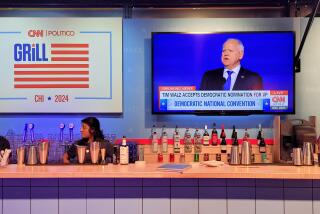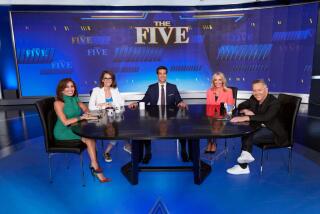TELEVISION ANALYSIS : C-SPAN: Where Viewers, Not Pundits, Do Talking
- Share via
It was Tuesday.
“Chevy Chase, Md., go ahead, please.”
“Brian, I just want to tell you, hands down, you’re the best interviewer on TV.”
Brian P. Lamb smiled, but it was a struggle, as if even this small display of emotion--you’d have thought his girdle was killing him--made him uncomfortable.
Lamb may not be television’s best interviewer. Yet his stony impassiveness and stoicism, along with a keen mind, make him an ideal one for C-SPAN, whose gavel-to-gavel coverage of this week’s Republican National Convention--including the cable network’s call-in segments and chats with conventioneers--has been strait-laced and unopinionated.
Predictably so in light of C-SPAN’s rigid policy of letting others do the talking. And strikingly so in contrast with the pundit-polluted coverage of CNN, ABC, CBS, NBC and PBS.
On C-SPAN, viewers are the only pundits.
Like pollsters whose job is only to elicit information, C-SPAN chairman and CEO Lamb and his on-air colleagues interview studio guests without reacting to answers. When it comes to hiding emotion, they’re a match for the guards at Buckingham Palace. If you’re fortunate to penetrate C-SPAN’s perpetually jammed lines, you get to say your piece, no matter how long or outrageous.
“C-SPAN is for deadbeats and Democrats who stay home all day and sit on their asses!” a Monday caller snapped at Susan Swain, the network’s senior vice president. Blank stare. “Thank you for calling,” she said.
That’s not to say opinion has no place in coverage of Democratic and GOP conventions that are little more than swollen, chauvinistic political commercials. Because its only message is information, however, Lamb’s cable industry-funded network--best known for airing the sessions of Congress--is a bracing alternative to the rest of television.
When it comes to delivering messages, TV can be tricky and extremely subtle.
The media usually get advanced copies of convention speeches, for example, allowing the networks to plot their crowd shots ahead of time. When the speaker refers to an issue concerning African-Americans, TV will be ready with a shot of a black face on the convention floor. And so on and so on.
The potential for distortion comes when the shots are not necessarily representative: When a shot of a single delegate wiping away tears gives the misleading impression that everyone on the floor is being profoundly moved by the speaker. Or when a shot of someone dozing gives the erroneous impression that everyone is bored. Or, as it happened on CBS Monday night, frequent shots of Latinos and African-Americans gave the impression that these minorities were present in multitudes when, in fact, together they represented less than 10% of the delegates on the floor of the GOP gathering.
Elsewhere on TV, the messages are often more straightforward, especially when it comes to those self-appointed sages of the airwaves, otherwise known as news anchors.
Not that there aren’t anchors who understand when to speak and when to shut up. One is CNN veteran Reid Collins, who repeatedly rejected analyst Ken Bode’s urgings Tuesday to say if he thought California Atty Gen. Daniel E. Lungren’s public allusion to Willie Horton--an African-American convict featured in that famous political ad attacking 1988 Democratic presidential candidate Michael S. Dukakis--resurrected the specter of racism.
“I don’t think people care what I think,” Collins said.
He was right. The same philosophy underpins C-SPAN, where this week everyone with cable can tune in after each night’s GOP convention speeches and hear the opinions of their fellow viewers, not pundits.
Overland Park, Kan., go ahead, please.
More to Read
The complete guide to home viewing
Get Screen Gab for everything about the TV shows and streaming movies everyone’s talking about.
You may occasionally receive promotional content from the Los Angeles Times.






